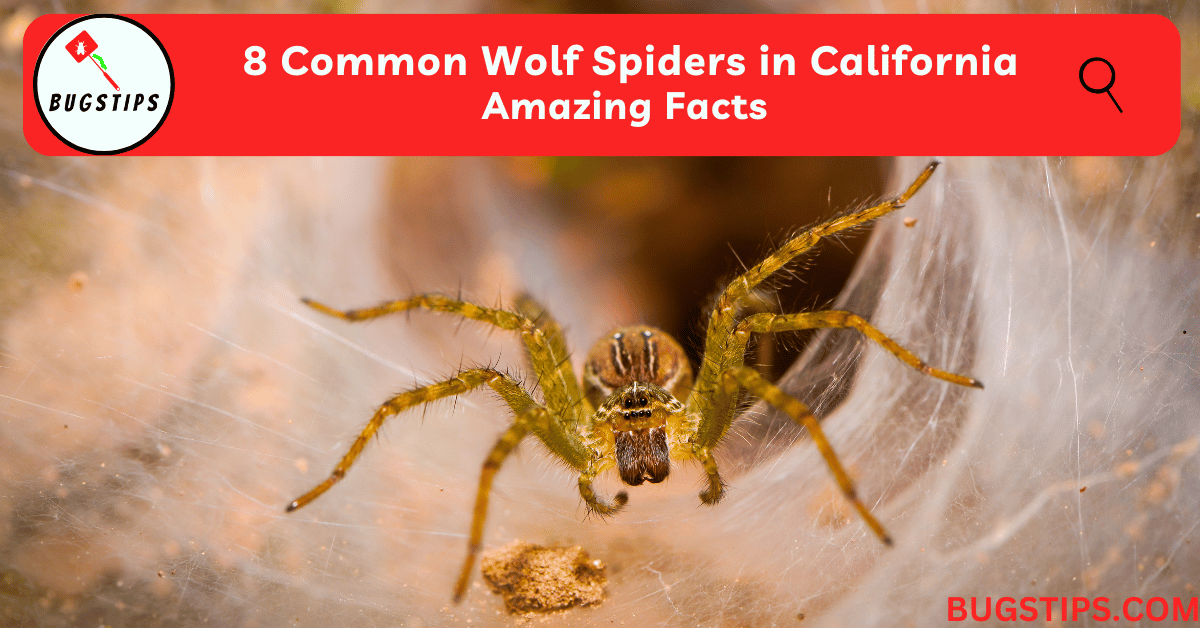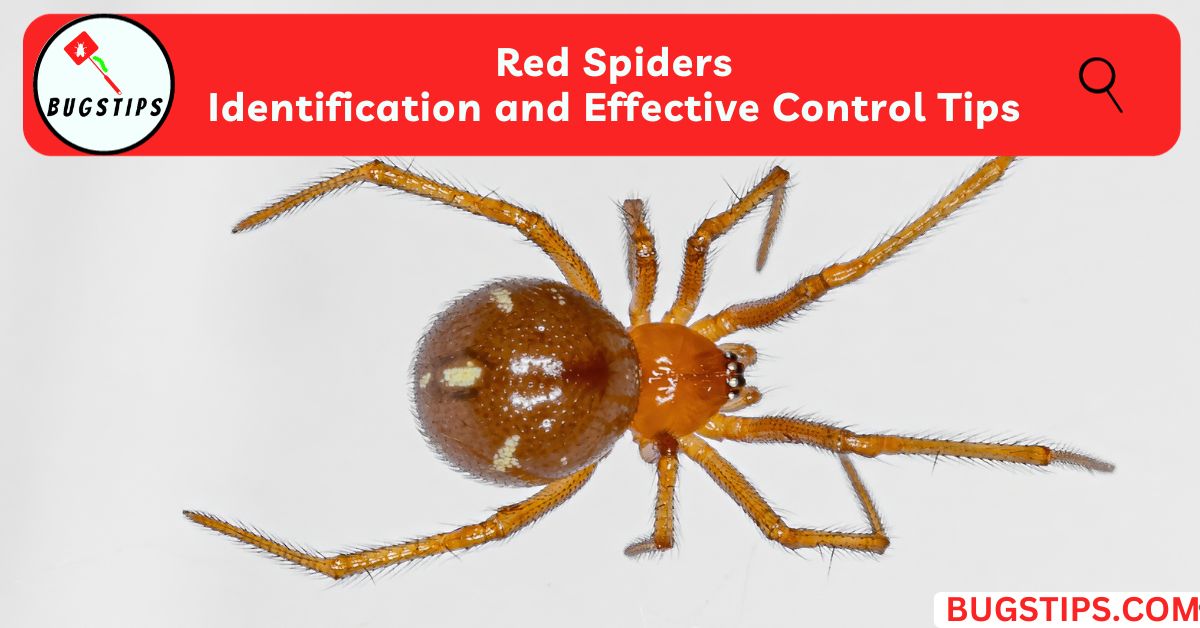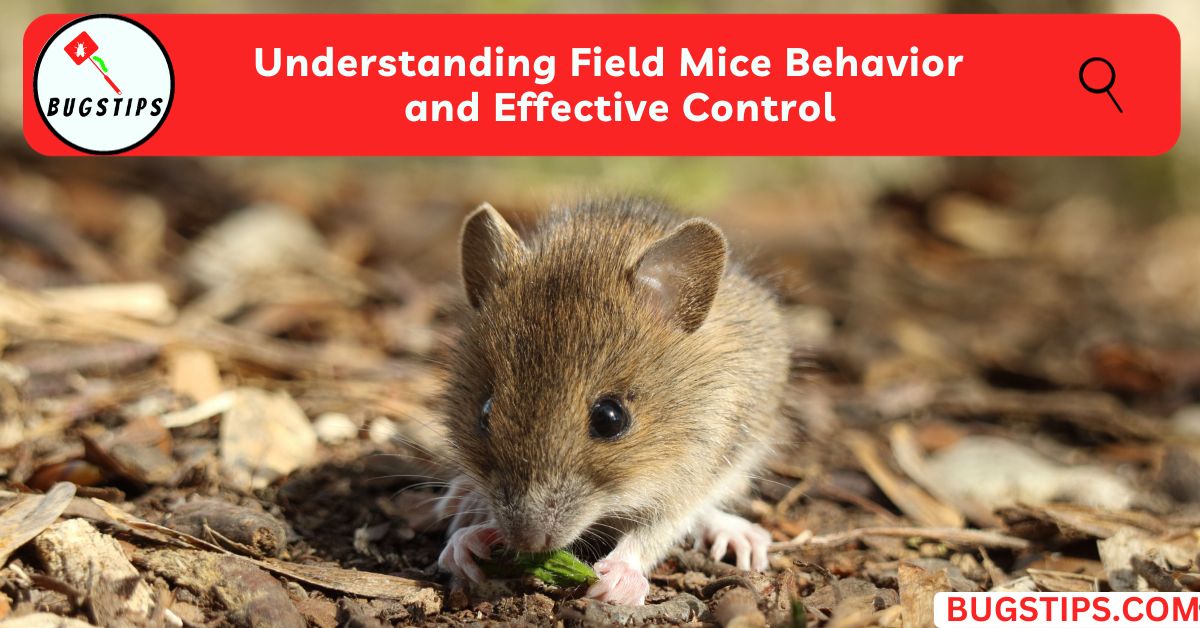This post may contain affiliate links which means as an Amazon Associate, this site may earn a small commission on qualified purchases made through links at no extra cost to you. Learn more on Affiliate Disclosure
Wolf spiders are a common type of spider found throughout many parts of California. With over 120 species from the Lycosidae family living in the state, wolf spiders in California display an intriguing diversity in habitats, behaviors, and appearances.
From tiny brown spiders blending into desert sands to larger fishing spiders scuttling along shorelines, wolf spiders can be found living both outdoors and indoors across California.
This article will provide an overview of wolf spiders in California, including where they live, what they eat, and how to identify different species that call the Golden State home.
Whether you love spiders or fear their eight-legged creepiness, learning more about wolf spiders in California can help provide insight into these abundant arachnids that lurk throughout the state.
What Are Wolf Spiders?
If you’re reading this article, you likely have some idea of what wolf spiders are. But for those who don’t, it’s helpful to cover the basics before diving into details about wolf spiders in California.
Wolf spiders belong to the Lycosidae family of spiders, a large and common group found worldwide.
They get their name from their tendency to actively hunt down prey, much like wolves hunt rather than build webs to catch food.
Wolf spiders use their keen eyesight and speed to seek out prey across the ground. They have a distinctive eye pattern, with two large eyes on top and an array of smaller eyes below.
Their colors range from mottled brown and grey to dark black, helping them blend into environments like forests and deserts as they hunt.
Wolf spiders don’t spin actual webs, but female spiders construct egg sacs to protect their young.
That covers some general info about the wolf spider family – Now let’s get into the diversity found right here in the state of California.
Related Article – Do Wolf Spiders Make Webs?
Are Wolf Spiders Common in California?
Wolf spiders are extremely common across nearly all of California. it is one of the most well-represented groups of spiders in the state.
They have been documented in abundance in a wide variety of environments from the coast to the mountains to the deserts.
Studies estimating spider populations have suggested there can be over 2,000 individual wolf spiders per acre in grassland areas.
Their numbers only increase around human habitations where food sources are plentiful.
Almost every Californian has likely come across these eight-legged predators lurking in their homes, garages, gardens, parks, and other surroundings.
The prevalence of wolf spiders throughout California reflects their impressive adaptability and success in inhabiting the diverse landscapes across the state.
You May Also Like – Are Banana Spiders Poisonous?
Where Do Wolf Spiders Live in California?
As mentioned previously, wolf spiders are found across a diverse range of habitats in California. This versatility allows them to make their home in many different parts of the state.
Wolf spiders often inhabit leaf litter and other sheltered areas on forest floors, hiding under decaying logs or rocks.
In grasslands, they burrow into the ground or nestle among tall grass blades and low-growing plants, while desert-dwelling wolf spiders take refuge under rocks, in dried-out mammal burrows, or tucked into shady crevices.
Along the California coast, the largest wolf spiders skitter among tide pools and rocky shores.
Some species have adapted to living near humans, taking up residence in man-made structures like basements, sheds, garages, and window wells.
Their flexibility in habitat allows wolf spiders to thrive in California’s varying climate zones from moist redwood forests to arid deserts to chilly mountain regions and nearly everywhere in between.
They lurk hidden in crevices and sheltered spots during the day, emerging at dusk to actively hunt across the landscape.
You May Also Like – Zombie Spiders | The Creepy Truth
Types of Wolf Spiders in California
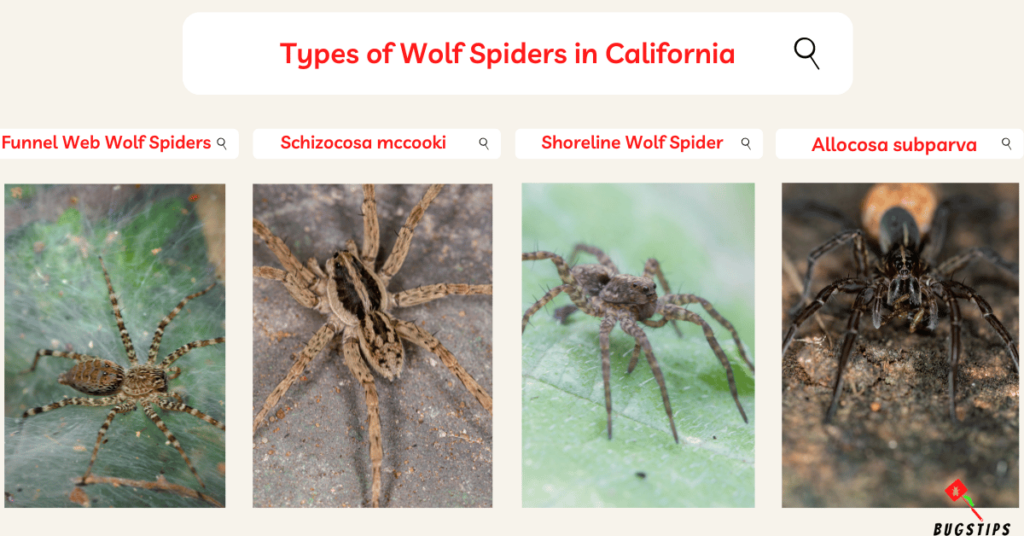
Funnel Web Wolf Spiders
- The funnel web wolf spider is a unique species found in California and the southwestern United States.
- Unlike most wolf spiders that actively hunt, the funnel web wolf spider builds a funnel-shaped web attached to the ground and waits for prey-like insects to fall in.
- The spider then envelopes the prey in silk or injects venom to immobilize it.
- The funnel shape allows the spider to retreat to the narrow end if threatened.
- Funnel-web wolf spiders are found in southern California scrubland habitats.
Schizocosa mccooki
- Schizocosa mccooki is a medium-sized wolf spider identified by the gray and brown banding on its legs.
- It is one of the “brush-legged” wolf spiders found in California that have furry or bristly-looking legs.
- S. mccooki inhabits grasslands, shrublands, and other open habitats where it hunts on the ground for insect prey.
- This species can be found throughout much of California.
Shoreline Wolf Spider
- As its name indicates, the shoreline wolf spider is found along beaches, coasts, and lakeshores in California and elsewhere in North America.
- Females are significantly larger than males.
- These dark-colored spiders with gray or yellow markings hunt in the intertidal zone and they can run quickly across the sand.
- Shoreline wolf spiders play an important role in these coastal ecosystems as predators.
You May Also Like – Do Spiders Poop?
Allocosa subparva
- Allocosa subparva is a small reddish-brown wolf spider with indistinct light striping on the abdomen.
- The males measure only 4.8-7.9mm in body length.
- This ground-dwelling species constructs horizontal sheet webs on sand dunes near shorelines in order to capture prey.
- Their small size and habitat make Allocosa subparva one of the lesser-seen wolf spiders in California.

Koch’s Wolf Spider
- Koch’s wolf spider is a large spider found in the mountain forests of California.
- Growing over an inch long, this brown species is known for pretending to play dead when threatened.
- Unlike social wolf spiders, Koch’s wolf spider hunts alone under rocks and low vegetation.
Hogna antelucana
- Hogna antelucana is one of the largest wolf spider species found in California, approaching 2 inches in body length.
- Colored tan with dark markings, these robust spiders inhabit varied environments including grasslands, open areas, and even urban settings.
- As voracious predators, H. antelucana helps control pest insect populations where they live.
Pirate Wolf Spider
- The aptly named pirate wolf spider has striking black and white banding on its face and legs that resembles a pirate’s stylish clothes.
- A small species less than half an inch long, these spiders lay camouflaged waiting to ambush passing prey.
- Found in leaf litter and low vegetation, pirate wolf spiders are active hunters from spring through fall in California.
Schizocosa maxima
- Schizocosa maxima is the largest of the “brush-legged” wolf spiders found in California.
- The females can grow over an inch long.
- Their legs are covered in dark fur-like bristles.
- An active ground hunter, this brown and gray spider inhabits wooded areas throughout California where it searches for insect prey.
What Do California Wolf Spiders Eat?
Wolf spiders in California are formidable predators that will eat just about any prey they can capture and overpower.
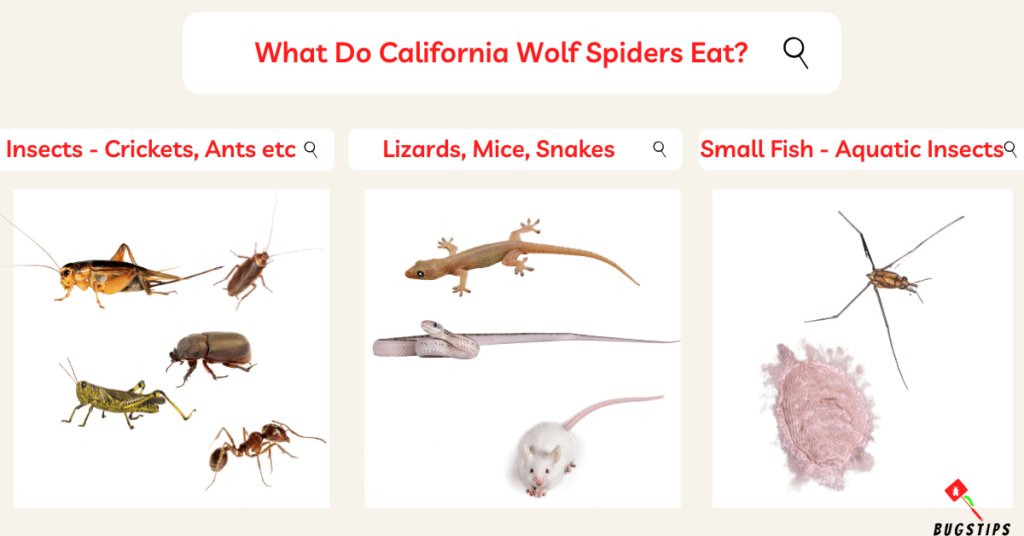
Their diet consists mainly of insects and other invertebrates such as crickets, grasshoppers, beetles, ants, cockroaches, millipedes, and spiders.
Larger wolf spider species will even attack small vertebrates like lizards, mice, and snakes.
The fishing spiders found along shorelines will plunge their fangs into tadpoles, small fish, and aquatic insects.
Wolf spiders use their excellent eyesight and speed to chase down prey once spotted.
The abundance and diversity of insect life in California provide wolf spiders with a reliable food source to maintain populations across diverse habitats in the state.
You May Also Like – 16 Green Bugs That Bite
Do California Wolf Spiders Jump?
Despite their name emphasizing running speed, wolf spiders found in California are actually able to jump as well.
They use their strong back legs to propel themselves into the air both to catch prey and when threatened.
Jumping allows them to suddenly change direction during high-speed hunts across the ground.
Larger wolf spiders may not have as impressive relative jumping power, but can still lunge multiple inches into the air when pouncing or evading predators.
So while running quickly is their primary means of movement, wolf spiders in California can and will jump when needed for hunting or escape.
Related Article – Should You Squeeze the Pus Out of a Spider Bite?
Are California Wolf Spiders Poisonous?
Wolf spiders found in California are not considered dangerous or poisonous to humans.
While they do produce venom used to subdue prey, their venom is not medically significant and poses little risk to people.
Wolf spiders have small fangs that cannot easily penetrate human skin. And they only bite when threatened or provoked – their first instinct is to flee rather than fight when encountered.
For these reasons, wolf spider bites on humans are very rare and only result in mild reactions like itching or swelling around the bite.
Their venom is specially adapted to act on invertebrate nervous systems, not mammalian ones.
So while the venom allows wolf spiders to swiftly overcome insect and arthropod prey, it does not cause harm to humans bitten.
You May Also Like – Are Jumping Spiders Friendly?
Can You Keep a Wolf Spider as a Pet?
As someone who has experience keeping tarantulas and other exotic pets, I can attest that wolf spiders can make fascinating captives for arachnid enthusiasts.
If you enjoy observing the behaviors of insects and invertebrates up close, wolf spiders are an active and rewarding species to keep.
I’ve kept a few different wolf spider species over the years in 10-20 gallon tanks filled with substrate they can burrow into.
Providing plenty of foliage, hides, and climbing opportunities allows them to exhibit their natural behaviors. Watching them hunt down crickets and other feeders is highly entertaining!
Females will produce egg sacs, so be prepared for hundreds of spiderlings to emerge that will need rehoming.
While I don’t recommend handling wolf spiders since they are prone to biting, simply observing their behaviors through the tank glass is rewarding.
Maintaining proper humidity and offering feeds 1-2 times per week will keep pet wolf spiders healthy for 1-3 years in captivity.
They require some specialized care but housing wolf spiders long-term can be done successfully with experience and research.
If you’re up for the challenge, wolf spiders will show you just how fierce and capable tiny predators can be!
You May Also Like – Does Lavender Repel Spiders?
Final Thoughts
Wolf spiders are clearly a successful group of arachnids, as evidenced by the diversity of species found across California.
Their adaptability allows them to thrive in habitats from sunny beaches to shady forests to arid deserts. Despite their imposing appearance, they pose little risk to humans beyond a minor bite.
Whether you spot a giant wolf spider prowling your basement or glimpse a tiny species scurrying through leaf litter, appreciate that you are witnessing a formidable predator perfectly evolved for hunting across the varied landscapes of California.
Learning to co-exist with these abundant spiders expands our understanding and interest in the natural world we inhabit together.
With new discoveries yet to be made, the range of wolf spiders in California provides opportunities for further study of these captivating creatures.
FAQs
Are there wolf spiders in California?
Yes, there are over 120 known species of wolf spiders that live in California. They are found across the state.
Are wolf spiders in California dangerous?
No, wolf spiders in California are not considered dangerous to humans. Their venom is not medically significant and they are not aggressive unless provoked. Wolf spider bites are very rare and cause only mild reactions.
What should I do if I see a wolf spider in California?
The best thing to do if you encounter a wolf spider in California is to simply leave it alone.
Gently capture and release it outside if found indoors. Do not attempt to handle or kill the spider, as this risks provoking a defensive bite.
Resources – (for further reading)
National Geographic – Wolf Spider Facts
University of Wisconsin–Milwaukee – Funnel Web Spider (Family Agelenidae)
Oxford University Press – FAMILY LYCOSIDAE • Wolf Spiders

